
22 minute read
OPORTO: A SUSTAINABLE CITY AUTOMÓVEIS ELÉCTRICOS SÃO MESMO O FUTURO? DEVO COMPRAR AGORA?
Advertisement

ALFREDO LAVRADOR
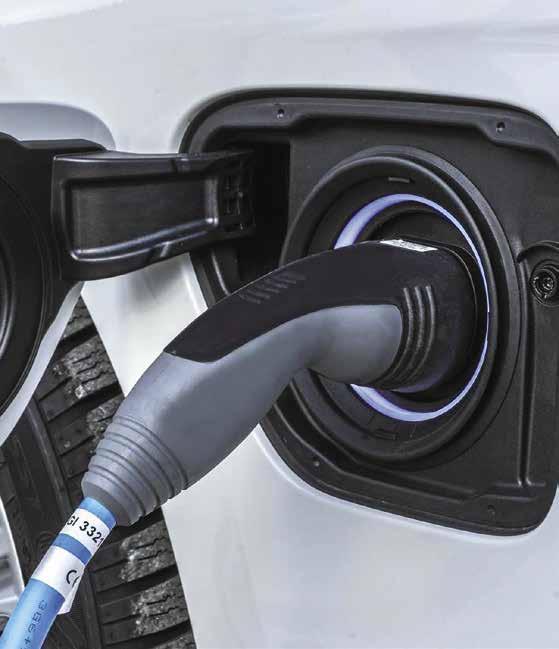

HÁ CADA VEZ MAIS VEÍCULOS ELÉCTRICOS À VENDA, O QUE FAZ COM QUE EXISTAM CADA VEZ MAIS DÚVIDAS NA MENTE DOS POTENCIAIS CLIENTES. SERÁ QUE OS AUTOMÓVEIS A BATERIA SÃO MESMO O FUTURO? DEVO COMPRAR JÁ?
THERE ARE MORE AND MORE ELECTRIC CARS ON SALE, WHICH MEANS THAT THERE ARE MORE AND MORE DOUBTS IN THE MINDS OF POTENTIAL CUSTOMERS. ARE BATTERYPOWERED CARS REALLY THE FUTURE? SHOULD I BUY ONE NOW?
Quando os cientistas se puseram de acordo sobre os motivos que aceleraram o aquecimento global, apontando o dedo às emissões de dióxido de carbono, os diferentes países, com a União Europeia à cabeça, decidiram agir. A produção de energia foi condenada a abandonar, a prazo, a queima de carvão e combustíveis fósseis, substituindo-os por fontes renováveis, enquanto aos transportes rodoviários foram impostas metas que obrigam a uma crescente percentagem de automóveis eléctricos no ‘mix’ de novas matrículas, para que estes atinjam 30% a 40% em 2030. A Comissão Europeia prepara-se para implementar em 2025 uma norma ainda mais restritiva, a Euro 7. Se a directiva for aprovada tal como hoje se conhece, a percentagem de veículos eléctricos em 2030 irá potencialmente duplicar, sendo que já há vários fabricantes que anunciaram não pretendem transaccionar veículos com motores de combustão dentro de 10 anos. Mas vamos às questões que preocupam a maioria dos condutores.
Quem deve adquirir um veículo eléctrico? Para agradar à maioria, os veículos eléctricos devem ter uma oferta variada, preços competitivos, baixos custos de utilização e garantir que a recarga da bateria não é uma experiência pouco prática. No actual nível de evolução, os automóveis eléctricos podem não ser ainda a solução ideal para todos os condutores, mas são uma opção válida para muitos deles. Os ‘early adopters’, o que inclui todos aqueles que têm um fraquinho pelas novas tecnologias, rapidamente aderiram aos eléctricos, mas para massificar a utilização de modelos exclusivamente alimentados a bateria é necessário que estes sejam também capazes de sensibilizar os clientes mais racionais. Aqueles para quem, se é óptimo poupar o ambiente, W hen scientists finally agreed on the reasons behind the mounting global warming, pointing the finger at carbon dioxide emissions, the different countries, and particularly the European Union, decided to act. The production of energy was condemned to give up, in the long term, the burning of coal and fossil fuels, replacing them with renewable sources, while on-road transportation goals were imposed, establishing that a growing percentage of electric cars in the mix of new registration plates close to 30% to 40% in 2030. The European Commission is about to implement an even more restrictive standard, e.g. Euro 7, in 2025. If the directive is passed with its current wording, the percentage of electric cars in 2030 will potentially double, and several manufacturers have already announced that they don’t intend to sell combustion engine cars in 10 years. But let’s get to the issues that worry most drivers.
Who should buy an electric car? To please most people, electric cars must have a diverse offer, competitive prices, and low operating costs and ensure that recharging the battery is not an impractical experience. In light of the current level of evolution, electric cars are probably not the right solution yet for all drivers, but they are nonetheless a valid option for many of them. Early adopters, including those who have a soft spot for new technologies, quickly join the bandwagon. But to spread the use of models powered by batteries only, its’ paramount to raise the awareness of most rational customers. Those who realize the importance of saving the environment but for who wish to have some advantages in terms of costs.
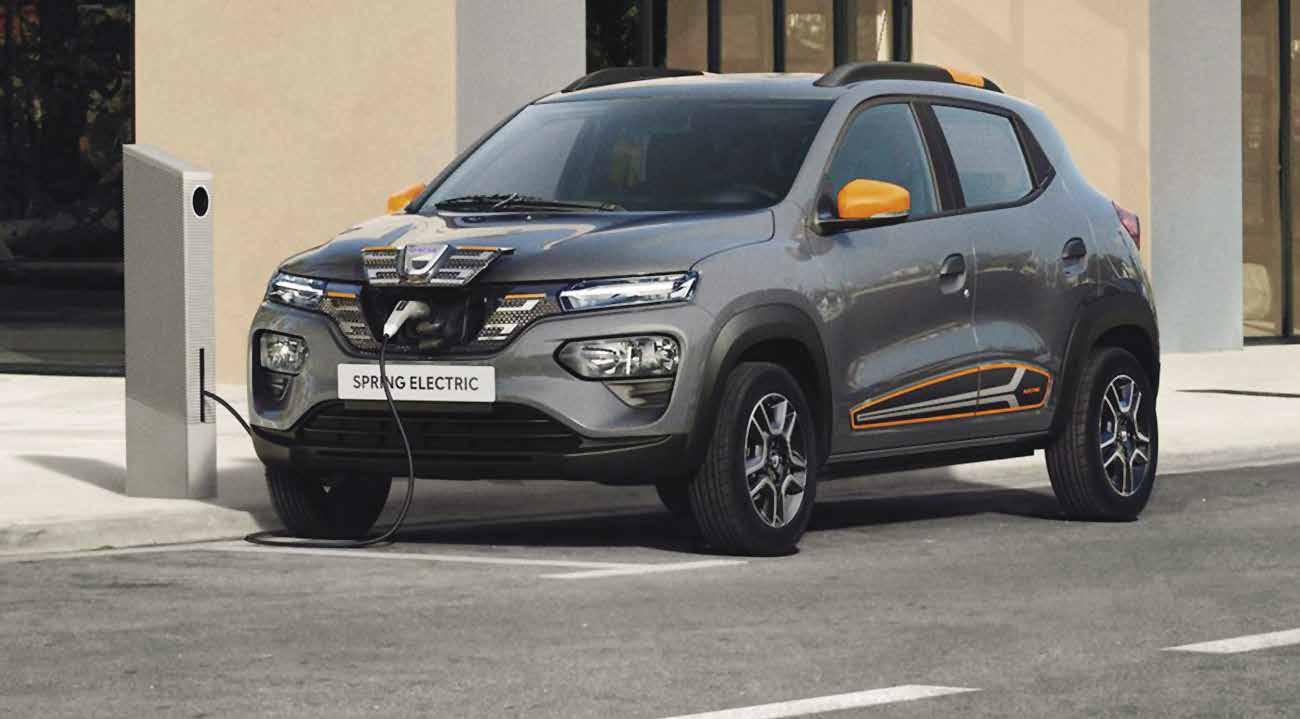
O DACIA SPRING VAI AGITAR O MERCADO A PARTIR DE ABRIL, COM UM PREÇO PRÓXIMO DOS 17.500€
DACIA SPRING WILL SHAKE THE MARKET FROM APRIL, WITH A PRICE CLOSE TO € 17,500
é fundamental usufruir de vantagens em termos de custos. Com uma oferta nacional que, de momento, vai dos 193 mil euros do mais caro dos Porsche Taycan aos cerca de 17.500€ do novo Dacia Spring, que irá surgir em Abril, é possível afirmar que há eléctricos para todos os gostos e bolsas. As vantagens em termos de preço, considerando os incentivos e os benefícios fiscais, sobretudo para as empresas, tornam os eléctricos competitivos face a versões equivalentes a gasolina ou a gasóleo, enquanto os custos de utilização são muito inferiores, sobretudo para quem possa recarregar em casa. Resta o carregamento da bateria, operação ainda morosa – excepto em casos pontuais – e que só não é um problema para quem possa alimentar a bateria em casa, ou então que consiga encontrar um posto livre e a funcionar próximo da sua habitação ou local de trabalho.
Os carros a bateria reduzem os custos? Deve ser pela carteira que os eléctricos têm de cativar os potenciais clientes, isto se o objectivo é democratizar as vendas, com as vantagens para o ambiente a serem assumidas como um (desejável) bónus. Se considerarmos dois dos pequenos veículos a bateria mais vendidos, como o Renault Zoe ou o Peugeot e-208, é possível percorrer 100 km com 1,5€, carregando em casa à noite com tarifa bi-horária. Dois modelos equivalentes a gasolina, o Clio e o 208, elevam os custos para cerca de 10€, quase sete vezes mais. À poupança com o combustível há que somar a redução nas despesas de manutenção. Mas é bom ter presente a perda de eficiência das baterias, que podem levar à sua substituição após o fim do período With a national offer that, at the moment, ranges from € 193 thousand for the most expensive Porsche Taycan to around € 17,500 for the new Dacia Spring, to reach the market in April, we may say that there are electric cars for all tastes and in all price ranges. The advantages in terms of price, considering the tax incentives and benefits, especially for companies, make electric cars more competitive compared to versions equivalent to gasoline or diesel, while the use costs are much lower, especially for those who will be able to recharge at home. Battery charging remains a time-consuming operation - except in specific cases - which won’t be a problem but only for those who can charge the battery at home, or for those who can find a free and operating charging station close to their home or workplace.
Do battery-powered cars reduce costs? The cost must be a driver to attract potential customers, if the objective is to democratize sales, with the advantages for the environment to be assumed as a (desirable) bonus. If we consider two of the best-selling small battery-powered vehicles, such as the Renault Zoe or the Peugeot e-208, it’s possible to travel 100 km with €1.5, charging at night with a dual tariff plan. Two gasoline-equivalent models, the Clio and the 208 raise costs to around € 10, almost seven times more. In addition to fuel savings, there is also a reduction in maintenance expenses. But we should bear in mind the issue of the loss of efficiency of the batteries, which may have to be replaced after the end of the warranty period (8 years or 160,000 km on average). This
O PORSCHE TAYCAN TURBO S É O ELÉCTRICO MAIS CARO DO MERCADO, À VENDA POR 193 MIL EUROS
THE PORSCHE TAYCAN TURBO S IS THE MOST EXPENSIVE ELECTRIC CAR ON THE MARKET, SELLING FOR € 193 THOUSAND
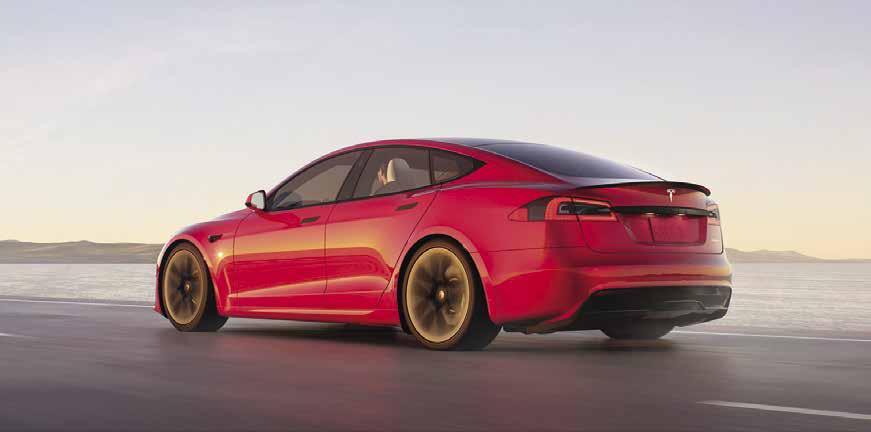
O TESLA MODEL S PLAID+ É A BERLINA DESPORTIVA MAIS VELOZ E COM MAIOR AUTONOMIA, AO ANUNCIAR 322 KMH E 840 KM
THE TESLA MODEL S PLAID + IS THE FASTEST SPORT SALOON WITH MORE AUTONOMY, E.G. 322 KM/840 KM
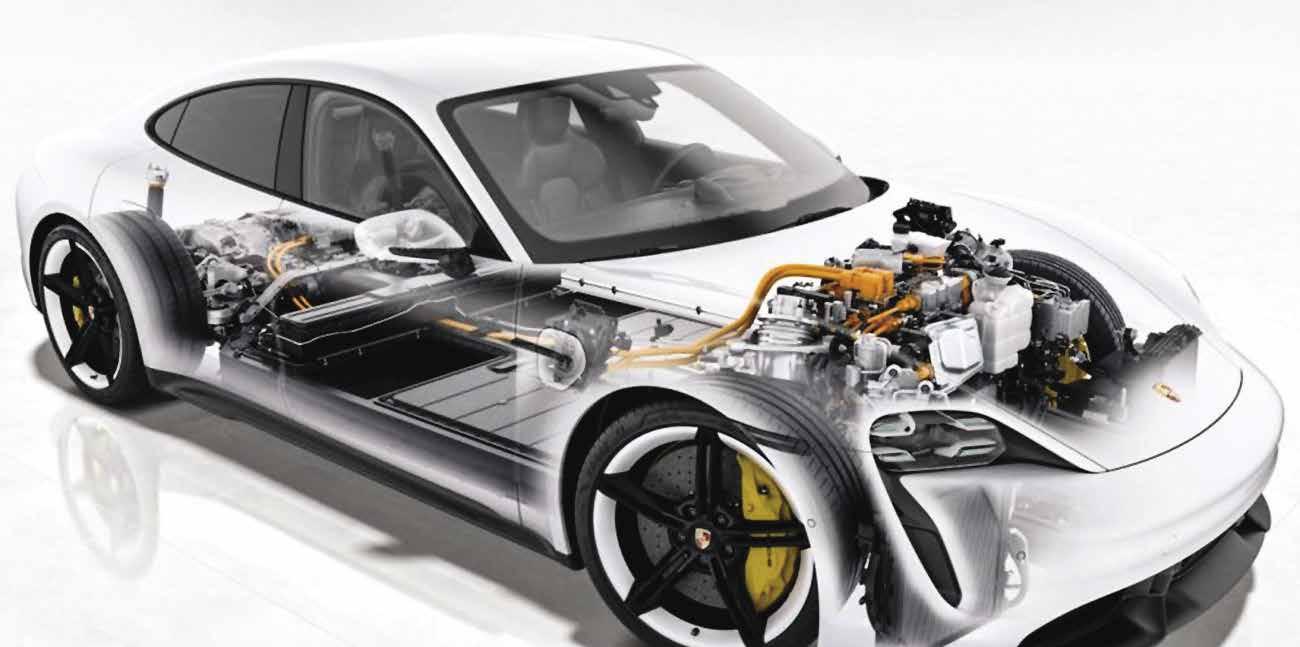
da garantia (em média 8 anos ou 160.000 km). Esta troca é dispendiosa e é mais frequente em baterias menos sofisticadas e, sobretudo, nos veículos que recorrem mais frequentemente a cargas rápidas.
Haverá energia para todos? A capacidade da rede eléctrica alimentar os veículos a bateria, especialmente quando o número de modelos em circulação aumentar, é outro dos “papões” que os defensores dos motores de combustão agitam. Mas na União Europeia ninguém manifestou preocupação a esse respeito. O que expectável é que os condutores sejam cada vez mais incentivados (com preços mais baixos) a recarregar durante a noite, em que o consumo é menor. E com a capacidade de os veículos fornecerem electricidade à rede com a mesma facilidade com que abastecem, os seus donos vão converter-se em ‘brokers’ de energia, recarregando o carro durante a noite, para depois vender energia à rede durante as horas de pico de consumo, encaixando com isso algum lucro.
Devo comprar já ou é melhor esperar? Esperar pelo eléctrico ideal é sempre uma opção mas, ao ritmo a que está evoluir a tecnologia, pode ter de aguardar anos. No entanto, há algumas certezas que podem contribuir para uma decisão mais esclarecida. A primeira é que os preços vão baixar. A prova é que vem aí o Dacia Spring, um SUV com um pequeno motor, uma autonomia de 230 km e um preço a rondar 14.000€ após incentivos. Também a Tesla já prometeu um eléctrico compacto por 25.000€ e a VW deverá ir ainda mais longe com o futuro ID.2, sendo certo que os restantes construtores não vão ficar parados. O ministro alemão da Economia, Peter Altmeier, o seu homólogo francês Bruno Le Maire e o vice-presidente da Comissão Europeia, Maros Sefcovic, fixaram como meta garantir fábricas de baterias no Velho Continente capazes de alimentar 7 milhões de veículos/ano, o que equivale a 50% da produção do mercado em 2020. l replacement is expensive and more frequent when it comes to less sophisticated batteries and, above all, for vehicles that use fast charges more often.
Will there be energy for everyone? The capacity of the electrical grid to power batterypowered vehicles, especially when the number of models in circulation increases, is another “bogeyman” that proponents of combustion engines often evoke. But in the European Union, no one has expressed concern about this. What is to be expected is that drivers will be increasingly encouraged (with lower prices) to recharge during the night, when consumption is lower. And with the ability for vehicles to supply electricity to the grid as easily as they charge, these car owners will convert into energy brokers, recharging their car during the night, selling then energy to the grid during peak consumption hours, thus making a profit.
Should I buy one now or is it better to wait? Waiting for the right electric car is always an option but, considering the pace of evolution of this technology, you may have to wait many years. However, certain facts may help you make a more informed decision. The first is that prices will go down. The proof is that Dacia Spring will be there soon, an SUV with a small engine, an autonomy of 230 km and a price of around € 14,000 after incentives. Tesla has also promised a compact electric for € 25,000 and VW is set to go even further with the future ID.2, and one thing is certain - the remaining manufacturers will not standstill. The German Minister of Economy, Peter Altmeier, his French counterpart Bruno Le Maire and the VicePresident of the European Commission, Maros Sefcovic, established the goal of ensuring battery factories in the Old Continent capable of supplying 7 million cars/year, which equals 50% of market production in 2020. l
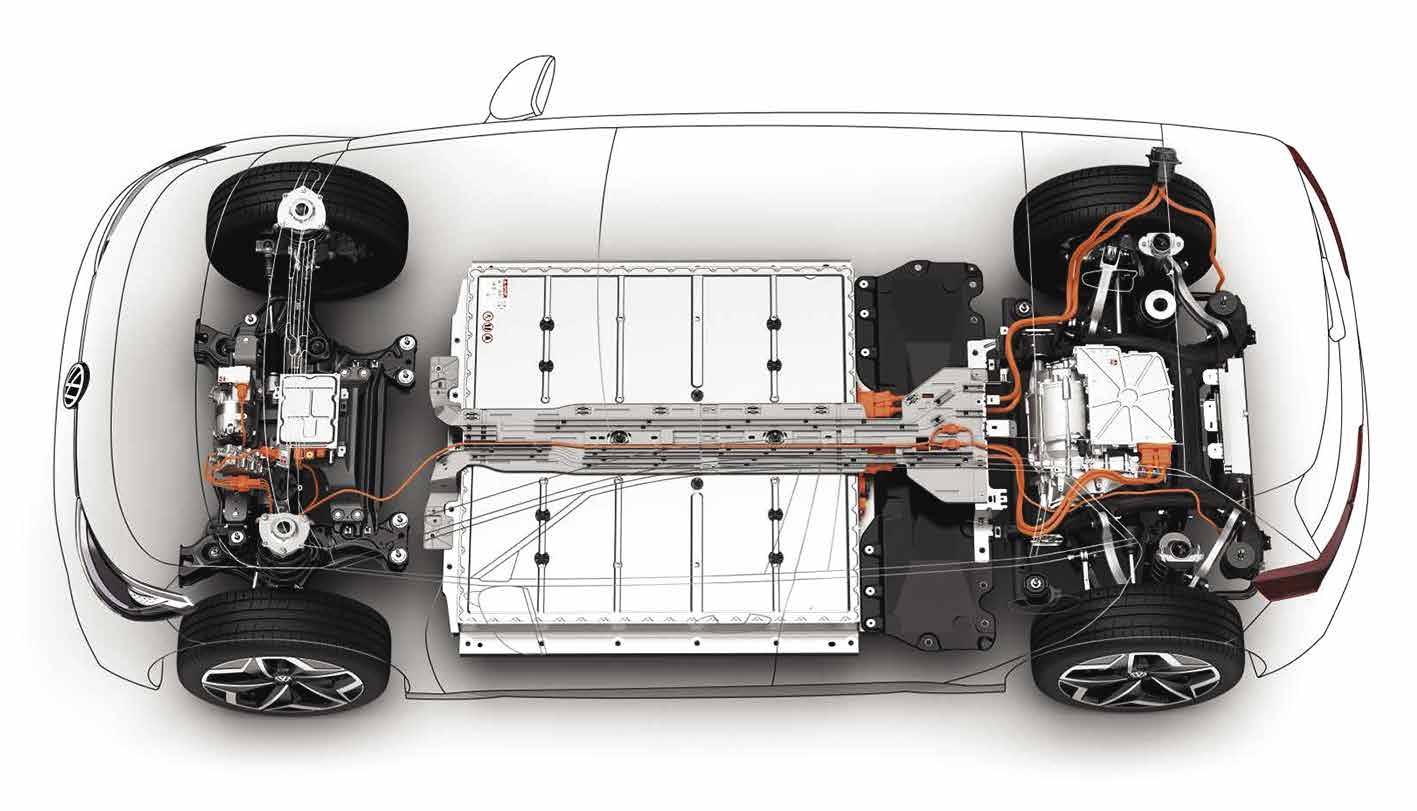
A PLATAFORMA MEB DO GRUPO VW PROMETE SER A MAIS PRODUZIDA DO MERCADO, POIS VAI SERVIR QUASE TODAS AS MARCAS DO GRUPO
THE MEB PLATFORM OF THE VW GROUP PROMISES TO BE THE MOST PRODUCED ON THE MARKET, AS IT WILL SERVE ALMOST ALL BRANDS OF THE GROUP
ENTREVISTA | INTERVIEW
ESTHER MUCZNIKA,
FUNDADORA E PRESIDENTE DO “TIKVÁ MUSEU JUDAICO DE LISBOA”

ESTHER MUCZNIKA,
FOUNDER AND PRESIDENT OF
THE “TIKVÁ MUSEU JUDAICO DE LISBOA”

CONTAR A HISTÓRIA DA PRESENÇA JUDAICA EM PORTUGAL DE UMA FORMA ATRACTIVA É O PRINCIPAL OBJECTIVO DO “TIKVÁ MUSEU JUDAICO DE LISBOA”, QUE IRÁ ABRIR PORTAS NA PRIMAVERA DE 2024. EM ENTREVISTA À PRÉMIO, ESTHER MUCZNIKA, FUNDADORA E PRESIDENTE DO “TIKVÁ MUSEU JUDAICO DE LISBOA”, FALA-NOS DESTE PROJECTO E DA SUA IMPORTÂNCIA, DO ARQUITECTO DANIEL LIBESKIND QUE LHE VAI DAR VIDA E EXPLICA-NOS A INCLUSÃO DA PALAVRA “TIKVÁ”, QUE SIGNIFICA “ESPERANÇA” EM HEBRAICO, NO NOME DO MUSEU.
TELLING THE STORY OF THE JEWISH PRESENCE IN PORTUGAL IN AN APPEALING WAY IS THE MAIN OBJECTIVE OF THE “TIKVÁ MUSEU JUDAICO DE LISBOA”, TO OPEN ITS DOORS IN THE SPRING OF 2024. IN AN INTERVIEW WITH PRÉMIO, FOUNDER AND PRESIDENT OF THE “TIKVÁ MUSEU JUDAICO DE LISBOA”, TOLD US ABOUT THIS PROJECT AND ITS IMPORTANCE, ABOUT ARCHITECT DANIEL LIBESKIND WHO WILL BRING IT TO LIFE AND THE REASON BEHIND USING THE WORD “TIKVÁ”, WHICH MEANS “HOPE” IN HEBREW, IN THE NAME OF THE MUSEUM.
O Museu Judaico de Lisboa vai finalmente avançar. Para quando está prevista a inauguração?
Sim, finalmente vai avançar, creio que reunimos hoje as melhores condições para concretizar este belo projecto. Prevemos a sua inauguração na Primavera de 2024
Qual o objectivo do Museu Judaico de Lisboa?
O principal objectivo do Museu é contar a história da presença judaica em Portugal de uma forma acessível e atractiva para o grande público. Trata-se de uma história judaica e portuguesa, ainda hoje em grande parte desconhecida da maioria da população portuguesa e estrangeira. Dito de outra maneira, queremos que os visitantes e amigos do Museu judaico entendam que a história que vamos contar faz parte da sua própria história. Também queremos mostrar que a diversidade de culturas é enriquecedora para um povo e um país e não uma ameaça à sua identidade.
Por adversidades várias, a localização do Museu mudou-se para Belém. Considera esta localização privilegiada?
A sua localização é de facto excelente: situada numa zona onde se encontram alguns dos mais visitados museus de Lisboa, é efectivamente um ponto de grande atracção turística, quer portuguesa quer estrangeira. Por outro lado, estamos perto do Tejo, na linha da Torre de Belém, que para além da sua
The Jewish Museum of Lisbon will finally go ahead. When is it scheduled to open?
Yes, it will finally go ahead, I believe that today we have the best conditions to carry out this beautiful project. We expect to open it in the spring of 2024
What is the purpose of the Jewish Museum in Lisbon?
The Museum’s main objective is to tell the story of the Jewish presence in Portugal simply and appealingly to the general public. This is Jewish and Portuguese history, still largely unknown to the majority of the Portuguese and foreign population today. In other words, we want visitors and friends of the Jewish Museum to understand that the story we are going to tell is part of their history. We also want to show that the diversity of cultures is enriching for a people and a country and not a threat to their identity.
Due to various adversities, the Museum’s location moved to Belém. Do you consider this a privileged location?
Its location is excellent: located in an area where some of the most visited museums in Lisbon are located, it is indeed a major tourist attraction for both Portuguese and foreign citizens. On the other hand, we are close to the Tagus, aligned with Torre de Belém, which in addition to its beauty,
beleza, evoca o importante papel que os judeus tiveram nos Descobrimentos Portugueses. A própria dimensão do terreno permite-nos aumentar as valências do Museu: para além da exposição permanente e das temporárias, temos espaço para um bom auditório, restaurante e loja, elementos importantes para o público e também fonte de sustentabilidade para o próprio museu.
Como se vão organizar as áreas expositivas e como se vai contar a história dos judeus portugueses e a sua contribuição para a nossa sociedade?
A primeira área expositiva será dedicada à cultura judaica, às suas tradições e costumes. As outras áreas expositivas seguem um percurso cronológico e temático. Abordaremos a vivência judaica no território que é hoje Portugal desde a época romana até à actualidade, mas centraremos o foco no período a que chamamos de “Convivência”, um período de relativa tolerância, entre o século XII e XV, que permitiu a contribuição fundamental dos judeus na medicina e na ciência, na descoberta de novos mundos e no seu financiamento, na filosofia e na impressão, entre outras. Seguir-se-á o espaço designado de “Intolerância” no qual serão evocados o Edito de Expulsão, as conversões forças e a instauração da Inquisição, elementos que conduziram ao êxodo judaico para países mais tolerantes e onde se destacaram inúmeras personalidades que também abordaremos. Terminamos com o que podemos apelidar de “Regresso” ou “Ressurgimento” do judaísmo em Portugal a partir de finais do século XVIII, novamente evocando a contribuição positiva judaica para a sociedade e o país. Em resumo, sem esquecer o lado sombrio da história judaico-portuguesa, insistiremos no seu lado positivo. Em primeiro ligar porque é a parte mais desconhecida e a mais significativa, e porque rejeitamos a visão de “vítimas” como redutora e desadequada. Pelo contrário, a ideia central que queremos transmitir é a de que os judeus ajudaram a construir Portugal.
Para além das áreas de exposição, que outras valências o Museu vai oferecer? Existirá uma programação própria destinada a crianças?
Com certeza, a programação para as crianças e escolas é uma das nossas prioridades. Teremos um serviço educativo que já está previsto incluindo uma equipa especializada no trabalho com as crianças, jovens e menos jovens e que já nos apresentou várias propostas muito interessantes. Um outro projecto será um centro de investigação patrocinado por um doador, virado especificamente para investigadores ou simplesmente pessoas que queiram estudar e conhecer melhor o nosso arquivo e outras fontes relacionadas com os temas do museu. Por seu turno, o auditório será utilizado para actividades várias, como cursos, conferências, ciclos de cinema e outros. Também poderá ser alugado para empresas ou outras instituições que aí desejam realizar eventos, aproveitando o restaurante e a cafetaria com a belíssima vista para o rio.
Na sua opinião, qual a importância de Museu Judaico para a cidade de Lisboa? Haverá um desconhecimento do público em relação a esta cultura?
evokes the important role that Jews played in Portuguese Discoveries. The size of the grounds allows us to increase the Museum’s assets: in addition to the permanent and temporary exhibitions, there is room for a good auditorium, restaurant and store, important elements for the public and also a source of sustainability for the museum itself.
How will the exhibition areas be organized and how will the story of Portuguese Jews and their contribution to our society be told?
The first exhibition area focuses on Jewish culture, its traditions and customs. The other exhibition areas follow a chronological and thematic route. We will approach the Jewish experience in the territory where Portugal is currently located, from Roman times to this day, but we will focus on the period we call “Coexistence”, a period of relative tolerance, between the 12th and 15th century, which opened the way for the fundamental contribution of Jews in medicine and science, in the discovery of new worlds and its funding, in philosophy and printing, among others. This will be followed by the space known as “Intolerance” in which the Expulsion Notice, the forced conversions and the establishment of the Inquisition will be evoked, elements that led to the Jewish exodus to more tolerant countries and where several personalities that we will also cover stand out. We end with what we can call the “Return” or “Resurgence” of Judaism in Portugal from the end of the 18th century, again evoking the positive Jewish contribution to society and the country. In short, without forgetting the dark side of JewishPortuguese history, we will insist on its positive side. First of all, because this is an unknown and significant part, and because we reject the view of “victims” as we consider it both limiting and inadequate. On the contrary, the central idea that we want to convey is that the Jews helped to build Portugal.
In addition to the exhibition areas, what other features will the Museum offer? Is there a specific program for children?
Certainly. Programs for children and schools are one of our priorities. We will have an educational service that is already planned, including a team specialized in working with children, young people and less young people, who have already presented us with several very interesting proposals. Another project will be a donor-sponsored research centre, aimed specifically at researchers or simply people who want to study and learn more about our archive and other sources related to the museum’s themes. In turn, the auditorium will be used for several activities, such as courses, conferences, movie cycles and others. It can also be rented to companies or other institutions wishing to host events there, taking advantage of the restaurant and cafeteria with the beautiful view of the river.
Não tenho dúvidas de que será uma mais-valia para a cidade de Lisboa e não só. Primeiro, como já referi, por contribuir para “desocultar” uma história e uma cultura riquíssimas e muito pouco conhecidas, mas também porque estou certa de que o projecto de arquitectura surpreenderá pela sua beleza e arrojo, marcando a cidade com mais uma peça de arte contemporânea que sendo audaciosa, se insere harmoniosamente nas cores e na luminosidade da natureza envolvente.
Existem vários Museus Judaicos pelo mundo, que contam a passagem dos judeus por esses países, muitos da autoria de Daniel Libeskind. O arquitecto polaco-americano desenhou os Museus de Berlim, São Francisco e Copenhaga, bem como memoriais do Holocausto nos Países Baixos, no Canadá e nos Estados Unidos, e ainda a reconversão do Ground Zero, em Nova Iorque. O que está projetado para o Museu de Lisboa?
Daniel Libeskind é considerado nos EUA, e não só, o arquitecto da memória. Um homem para quem, e segundo as suas próprias palavras, “a memória é a base de toda a construção”. No nosso caso concreto, ele interessou-se muitíssimo pela história que vamos contar e no seu projecto incluiu uma outra vertente: a Esperança. Aliás é com base na sua proposta que o nome do Museu será “Tikvá Museu Judaico de Lisboa”, sendo que a palavra Tikvá significa “Esperança” em hebraico. No seu projecto, cada módulo do edifício representa uma letra da palavra Tikvá em hebraico. Por outro lado, Libeskind que já conhecia Lisboa, também fez questão de integrar componentes da arte portuguesa. O museu terá assim vários elementos revestidos com o típico azulejo de cor azul.
Quanto se prevê que custará este projecto e como, uma pessoa ou empresa, apoiar este projecto?
Estimamos o custo do Museu em cerca de 15 milhões de euros e qualquer pessoa ou empresa pode apoiar através de donativos, patrocínios ou subscrições a curto, médio ou longo prazo. Todos estes procedimentos estão a ser cuidadosamente preparados precisamente. As doações de peças também são uma forma muito importante de apoio.
Quantos visitantes estimam atrair por ano? À semelhança do que acontece em outras cidades, acha que o Museu Judaico de Lisboa poderá torna-se uma das atracções turísticas da capital portuguesa?
A nossa estimativa antes da pandemia, tendo em conta as estatísticas disponibilizadas pelos museus e pelo turismo, era de 100.000 pessoas por ano. Mantemos essa estimativa na expectativa de quando o museu for inaugurado já se tenha regressado a uma situação de segurança sanitária. E sim, acreditamos que o museu pelas características acima apontadas tanto do conteúdo, como da arquitectura, será uma das atrações turísticas da cidade de Lisboa. l
In your opinion, what is the importance of the Jewish Museum for the city of Lisbon? Is there a lack of public awareness of this culture?
I do not doubt that it will be an asset to the city of Lisbon and beyond. First, as I mentioned, for helping “unveiling” a very rich and little-known history and culture, but also because I am sure that the architectural project will surprise by its beauty and boldness, marking the city with yet another piece of art contemporary that being audacious, fits harmoniously in the colours and luminosity of the surrounding nature.
There are several Jewish Museums around the world, which tell of the passage of Jews through these countries, many of them by Daniel Libeskind. This polish-american architect designed the Museums of Berlin, San Francisco and Copenhagen, as well as Holocaust memorials in the Netherlands, Canada and the United States, as well as the rebuilding and renovation of Ground Zero in New York. What is designed for the Lisbon Museum?
Daniel Libeskind is considered the architect of memory in the USA and elsewhere. A man for whom, according to his own words, “memory is the basis of all construction”. In our specific case, he was very interested in the story that we are going to tell and in his project he included another aspect: Hope. It is based on your proposal that the name of the Museum should be contained in this “Tikvá Museu Judaico de Lisboa”, the word Tikvah meaning “Hope” in hebrew. In your project, each module in the building represents a letter from the hebrew word Tikva. On the other hand, Libeskind, who already knew Lisbon, also made a point of including components of Portuguese art. The museum will thus have several elements covered with the typical blue coloured glazed tiles.
How much is this project expected to cost and how can individuals or companies support this project?
We estimate the cost of the Museum to be around 15 million euros and any person or company can support through donations, sponsorships or subscriptions in the short, medium or long term. All of these procedures are being carefully prepared precisely. Donations of objects are also a very important means of support.
How many visitors do you estimate to attract each year? As in other cities, do you think that the Jewish Museum of Lisbon could become one of the major tourist attractions in the Portuguese capital?
Our estimate before the pandemic, taking into account the statistics provided by museums and tourism, was 100,000 people a year. We stick to this estimate in the expectation that by the time the museum opens, it will have returned to a health security situation. And yes, we believe that the museum, due to the aforementioned characteristics, both in terms of content and architecture, will be one of the tourist attractions in the city of Lisbon. l








